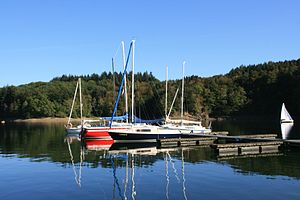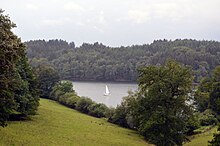Bevertalsperre
| Bevertalsperre | |||||||||
|---|---|---|---|---|---|---|---|---|---|
|
|||||||||
|
|
|||||||||
| Coordinates | 51 ° 8 '27 " N , 7 ° 22' 21" E | ||||||||
| Data on the structure | |||||||||
| Construction time: | 1896–1898 and 1935–1938 / 39 | ||||||||
| Height above foundation level : | 49 m | ||||||||
| Height above the river bed : | 35 m | ||||||||
| Building volume: | 985,000 m³ | ||||||||
| Crown length: | 520 m | ||||||||
| Data on the reservoir | |||||||||
| Altitude (at congestion destination ) | 295.53 m above sea level NN | ||||||||
| Water surface | 200 ha | ||||||||
| Storage space | 23.7 million m³ | ||||||||
| Catchment area | 72 (or 25.7?) Km² | ||||||||
| Design flood : | 46 m³ / s | ||||||||
| Aerial view | |||||||||
The Bevertalsperre is a dam built between 1896 and 1898 in the Oberbergisches Kreis in North Rhine-Westphalia . It is mostly located in the urban area of Hückeswagen , and to a small extent also in Radevormwald and Wipperfürth . The Bever , a tributary of the Wupper, is dammed up .
history
Originally, a barrier wall was built in the village of Wefelsen based on the Intze principle . After its inauguration on October 8, 1898, the dam had a capacity of 3.3 million m³. It was the first usable water dam in the Wupper area. After it was expanded in 1938, it holds 23.7 million m³. The old barrier wall was removed in the upper area and a much larger dam was built further south . This is a rock embankment dam with a steel inner seal.
Water management
The catchment area of the new dam increased to 25.7 km²; the mean annual inflow is 21.4 million m³. With a traffic jam target of 295.53 m above sea level. NN , the new Bevertalsperre has a capacity of 23.7 million m³ and was the largest dam in the Wupper area and Wupperverband until the Wupper dam was completed in 1987 .
With the new dam, an improvement in flood protection and a better low water flow in the Wupper should be achieved. Many floods caused considerable damage in the cities and communities of the Wupper area; The low water supply of the Wupper in the summer months with a simultaneous increase in the amount of sewage due to the growing population and industrialization had caused considerable nuisance to the population, especially in the lower Wupper. It was also clear that with a more even water flow in the Wupper, the engines and the water extractors would have advantages.
Today, the dam system, consisting of Lingese , Brucher , Bever and Wuppertalsperre , ensures that up to 5 m³ / s of water flow in the Wupper even in dry seasons, measured at the Kluserbrücke gauge in Wuppertal .
Purpose of the dam
The reservoir does not contain drinking water , but is used for flood protection , low water elevation and as an overflow for the neighboring Neyetalsperre . Bevertalsperre and Neyetalsperre are therefore connected by a tunnel called the Bever block . The body of water, which is up to 200 hectares in size, depending on the water level, is now a very popular recreational area with many leisure opportunities.
Dam wall
When the dam was inaugurated in 1898, a dam wall was first built in Wefelsen. During the expansion in 1938, a new dam was built elsewhere.
The old dam
The data of the old dam wall at a glance:
- Height above foundation: 25 m
- Height of the wall crown: 288.25 m above sea level NN
- Crown width: 4 m
- Sole width: 17 m
- Congestion destination: 287.03 m above sea level NN
The new dam
After the Wupper Law came into force on January 8, 1930, the Wupper Association was established. His first major project was the construction work for the new dam and thus also for the construction of a new dam wall. They began in the spring of 1935 based on a design by government architect Harald Link. The extensive, difficult foundation work took almost two years. The embankment was essentially completed in 1937, 33,000 m³ of concrete and around 1,000,000 m³ of soil had to be installed. In addition to numerous large machines, up to 650 people were employed on the construction site. The "new" Bevertalsperre was officially put into operation in 1938. The dam has a vertical core seal made of an 8 mm thick, corrugated sheet steel wall with sealing clay in front of it, which in turn is covered by rocky clay and a strong stone packing on the water side. A sand-gravel filter is installed on the air side of the sheet steel wall, to which the supporting body of the dam made of permeable soil layers is attached. The welded sheet steel wall rests on a concrete base (hearth wall) through which an inspection passage leads. From this passage, the subsoil was compacted to a depth of 30 m by cement grouting. The Wupperverband still offers guided tours through the dam today.
Freetime activities
Apart from motor boating, all water sports are allowed. Sailboats are generally approved up to a length of 24 feet, but catamarans are limited to a length of 14 feet. A usage badge is required to use the dam with water vehicles such as sailing boats, rowing boats or inflatable paddle boats. This can be bought at the campsites and from the Wupperverband in the form of weekly and annual badges. There are four campsites around it. The water quality is described as "good" by the Ministry of the Environment .
In earlier times, the Bevertalsperre was also used outside of today's access points by so-called “wild beaches”. These beaches were particularly popular because of the lack of security staff, nudists and normal bathers mixed here . Problems with garbage disposal and, above all, the lack of safety measures in the event of swimming accidents ensured that these beaches were closed with sometimes drastic measures.
At the Bevertalsperre , the Segler Vereinigung Wuppertal e. V., the Bergischer Segelverein 1988 e. V. and the Remscheid sailing yacht club Bevertalsperre e. V. three sailing clubs are located, which organize several, partly national regattas on the Bevertalsperre.
For this reason, the Bevertalsperre was used as the location for the film Summer Storm in 2003 .
Apart from the use of watercraft are on, or in the Bevertalsperre, the diving , fishing and swimming possible. On the weekends of the season as well as during the major holidays, the stations of four German Life Rescue Society local groups (DLRG) ( Hückeswagen , Radevormwald and the Wuppertal district with the Barmen and Elberfeld-Vohwinkel departments) at the Bevertalsperre ensure safety in particular of bathers.
The old barrier wall is a worthwhile destination for advanced divers. You can find large valves and an old telephone attached to the wall. The depth at this point is up to 29 meters, the water is cold and dark.
Places at the Bevertalsperre
Mickenhagen - Wefelsen - Käfernberg - Großberghausen - Reinshagenbever - Höhe - Kleinhöhfeld - Siepersbever - Stoote
Water rescue
At the Bevertalsperren, the DLRG water rescuers from the local groups Hückeswagen and Radevormwald (Oberbergischer Kreis district) and the Barmen and Elberfeld-Vohwinkel departments (Wuppertal district) ensure the safety of water sports enthusiasts.
See also
literature
- Wolfgang Völkel, Norman Schorl: The Bevertalsperre. Sutton Verlag, Erfurt 2007, ISBN 978-3-86680-219-3 .




